3 Chicks and one to go!
May 12, 2017 in In the Nest Box
May 12, 2017 in In the Nest Box
May 11, 2017 in In the Nest Box
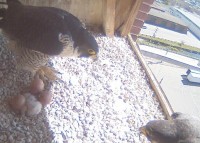 Male and female in nest box in middle afternoon with first chick hatched and other 3 eggs ready to hatch!
Male and female in nest box in middle afternoon with first chick hatched and other 3 eggs ready to hatch!
Inside the egg, the Peregrine chick has its head tucked under its wing. A large muscle called the hatching muscle runs from the middle of the neck to the top of the head. About 30 days after incubation has started, this muscle contracts. The chick’s head snaps up and the egg tooth, a hard pointed knob on top of the beak, cracks the inside of the eggshell. This creates a “pip” – a small hole with tiny cracks spreading out across the shell. One to two days after pipping, the chick begins moving around in the shell. The egg tooth scrapes against the eggshell, cutting a ring through it. Around 31 days after the egg is laid, the chick breaks out.
May 10, 2017 in In the Nest Box
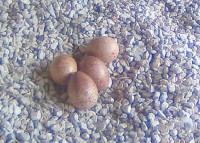 After 30 plus days of careful and shared incubation duties of the 4 eggs by both male and female, the time has come for the chicks to hatch. We are likely a day away at most from the first hatch! Here is a late afternoon view of the 4 eggs while the female is taking a regular break in the non-stop process of incubating the eggs.
After 30 plus days of careful and shared incubation duties of the 4 eggs by both male and female, the time has come for the chicks to hatch. We are likely a day away at most from the first hatch! Here is a late afternoon view of the 4 eggs while the female is taking a regular break in the non-stop process of incubating the eggs.
April 26, 2017 in In the Nest Box
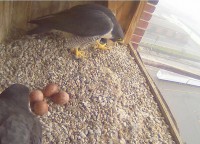 The Lawrence Peregrines are well along in the month long incubation process. The normal clutch is four eggs, laid on alternate days. Incubation, usually initiated when the third egg is laid, is usually 29 to 33 days based on history at this location. Clutches of three or five eggs are known to happen but less so at this site over past number of years. Both sexes share incubation. The male takes a lesser role, often replacing the female after catching prey in the early morning. here you are able to see a changing of the guard!
The Lawrence Peregrines are well along in the month long incubation process. The normal clutch is four eggs, laid on alternate days. Incubation, usually initiated when the third egg is laid, is usually 29 to 33 days based on history at this location. Clutches of three or five eggs are known to happen but less so at this site over past number of years. Both sexes share incubation. The male takes a lesser role, often replacing the female after catching prey in the early morning. here you are able to see a changing of the guard!
April 19, 2017 in In the Nest Box
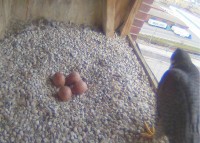 As the incubation process continues, many have asked for more specifics about how it all works?
As the incubation process continues, many have asked for more specifics about how it all works?
Heat makes the eggs start developing. When the eggs reach about 98.6°F, or 37°C the egg begins changing into an eyas. Conveniently enough, a Peregrine’s natural body temperature is about 103°F, or 39.5°C, so to heat up the eggs all they need to do is to get some of that body heat onto the eggs. Now, a Peregrine’s feathers make very good insulation. That’s how they can stand to stay out in cold temperatures without freezing to death. But while those feathers keep the cold air away from the falcon’s skin, they also keep their body heat from getting out. So to incubate the eggs, the Peregrine carefully settles down, shifting from side to side to get the eggs beneath their feathers. Falcons have brood patches, areas on their breasts with a lot of blood vessels close to the surface of their skin. The blood vessels concentrate their body heat, making it easier to transfer the heat to the eggs. Both adults have brood patches, though his are smaller than hers, which makes sense since he’s a smaller bird.
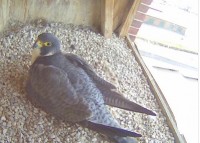 Peregrines incubate their eggs for 29 to 33 days. In the early days of brooding it’s important to keep the eggs as close to their ideal incubating temperature as possible. Too hot or too cool and the eggs won’t develop properly. Later in the incubation process, proper temperature isn’t quite as important. In fact, after a couple of weeks the falcons will be able to leave the eggs uncovered for longer periods of time. Sometimes leaving the eggs uncovered frequently, or for long periods can mean that the eggs hatch a few days later than normal. For the Lawrence Peregrines, their nest box is in a place where it’s not likely to be disturbed, so they most often incubate steadily until the eggs hatch.
Peregrines incubate their eggs for 29 to 33 days. In the early days of brooding it’s important to keep the eggs as close to their ideal incubating temperature as possible. Too hot or too cool and the eggs won’t develop properly. Later in the incubation process, proper temperature isn’t quite as important. In fact, after a couple of weeks the falcons will be able to leave the eggs uncovered for longer periods of time. Sometimes leaving the eggs uncovered frequently, or for long periods can mean that the eggs hatch a few days later than normal. For the Lawrence Peregrines, their nest box is in a place where it’s not likely to be disturbed, so they most often incubate steadily until the eggs hatch.
April 10, 2017 in In the Nest Box
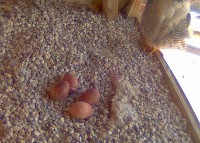 The female Peregrine in Lawrence has finally laid all four eggs, a bit later than usual for this location. Here’s how the process works. Once fertilization occurs the egg begins moving down her oviduct. It’s sort of on an assembly line where the egg gets built, layer by layer. First comes several coatings of yolk. The egg moves a little farther down the ovidicut where it gets covered with albumen (the clear fluid that we’d call egg white) and various membranes. Then it continues on its way until shortly before she’s ready to lay the egg, it gets its final layer, the shell. The whole process takes a little more than a day.
The female Peregrine in Lawrence has finally laid all four eggs, a bit later than usual for this location. Here’s how the process works. Once fertilization occurs the egg begins moving down her oviduct. It’s sort of on an assembly line where the egg gets built, layer by layer. First comes several coatings of yolk. The egg moves a little farther down the ovidicut where it gets covered with albumen (the clear fluid that we’d call egg white) and various membranes. Then it continues on its way until shortly before she’s ready to lay the egg, it gets its final layer, the shell. The whole process takes a little more than a day.
The actual act of laying the eggs can take as little as a few minutes or as long as an hour or more. When she’s ready to lay her egg, the female will sit in the scrape. She may look like she’s sleeping, or at least taking a nap, but if you watch carefully, you’ll notice that she starts to move around as the egg is laid. She typically keeps the egg covered after it’s laid for 10 to 20 minutes before moving off the nest and letting us have a good look.
Peregrine eggs are speckled, and vary in color from light pink to darker brown or purple. Older falcons may produce lighter colored eggs. Each one is about the size of a small chicken egg.
One bit of behavior that many people find unusual is that she won’t begin incubating the eggs, or brooding, right away. Believe it or not, that’s perfectly normal for Peregrines. She’ll begin brooding when the next to last egg is laid, so when she starts, we can be pretty sure we know how many eggs she’ll lay– just add one to the current number. Before then, she’ll mostly leave the eggs uncovered. Don’t worry though– Peregrine eggs can survive just fine unless the temperature drops below freezing. If that happens, she’ll sit on the eggs just to keep them warm enough to stay viable. We’ll talk more about brooding and incubation soon. In the meantime, keep watching!
In this photo on Monday morning after the last eggs were laid over the weekend, the female is taking a break and resting on the outer edge of the nest box!
March 30, 2017 in In the Nest Box
October 4, 2016 in In the Nest Box
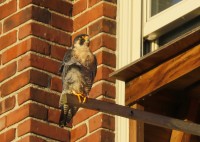 One of the great joys is stopping the Ayer Mill Clock Tower to search and find at least one of the peregrine falcons. It’s always a treasure hunt and a delight when locating one of the falcons. Tonight the search was easy as the banded male falcon was sitting on the wooden perch pole at the nest box in beautiful late day light less that an hour before sunset!
One of the great joys is stopping the Ayer Mill Clock Tower to search and find at least one of the peregrine falcons. It’s always a treasure hunt and a delight when locating one of the falcons. Tonight the search was easy as the banded male falcon was sitting on the wooden perch pole at the nest box in beautiful late day light less that an hour before sunset!
September 29, 2016 in In the Nest Box
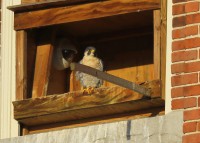 With terrific late afternoon sunlight, made a pass by the Clock Tower in Lawrence for a look at the peregrines. The adult peregrine was perched on the outside rim of the nest box window with beautiful westward views in the late day light. For no clear reason, the female was nearby on an upper ledge squawking away. The male showed no interest or reaction and neither of them moved!
With terrific late afternoon sunlight, made a pass by the Clock Tower in Lawrence for a look at the peregrines. The adult peregrine was perched on the outside rim of the nest box window with beautiful westward views in the late day light. For no clear reason, the female was nearby on an upper ledge squawking away. The male showed no interest or reaction and neither of them moved!
September 15, 2016 in In the Nest Box
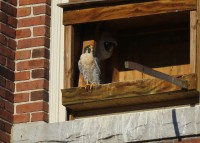 Both adult peregrines are being seen around the Clock Tower in Lawrence. It was nice to get late afternoon looks at the adult male this afternoon as he quietly perched int he late day sun on the outer edge of the nest box. The view angle provided just enough of a vantage point to observe and photo capture his left leg bi-colored bands showing 6/4. This falcon is now just over 15 years old and continues his long standing residence in Lawrence with yet another very productive breeding season behind him!
Both adult peregrines are being seen around the Clock Tower in Lawrence. It was nice to get late afternoon looks at the adult male this afternoon as he quietly perched int he late day sun on the outer edge of the nest box. The view angle provided just enough of a vantage point to observe and photo capture his left leg bi-colored bands showing 6/4. This falcon is now just over 15 years old and continues his long standing residence in Lawrence with yet another very productive breeding season behind him!